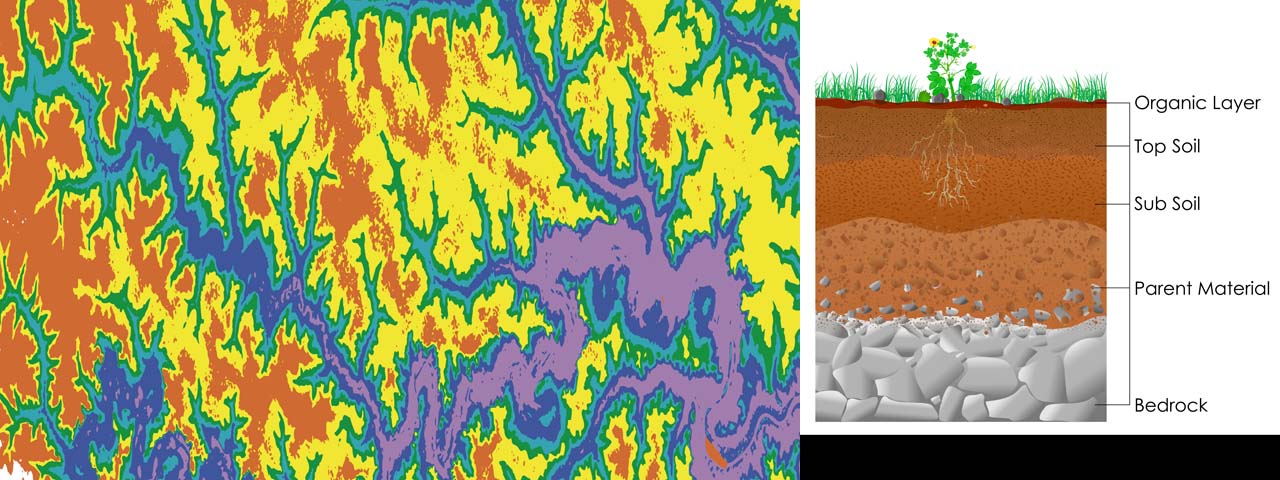
What is the maximum exploration depth of Geonics equipment?
How deep can Geonics equipment explore?
That depends on what piece of equipment the user is using.
The maximum exploration depth of Geonics equipment that measures ground conductivity and magnetic susceptibility, such as the EM-31, EM-38, and EM-34, is dependent on the selected intercoil spacing and orientation of the coils. In other words, the distance between the transmitter and receiver and if the measured response reflects a horizontal or vertical dipole determines the depth of exploration. Like most electrical methods, the type of subsurface material and the stratigraphy plays an important role. Geonics Technical Note TN-6 covers this topic in great detail (or view it here TN6 EM at Low Induction Numbers). Last but not least, an operator should be aware that the vertical dipole mode is less sensitive to surface material than the horizontal dipole mode, see figure of relative resp0nse curves.
The accumulative response of the EM31 with an intercoil spacing of 3.7 meters
results in an exploration depth of approximately 6 meters in the vertical dipole mode. When the EM31 is turned on its side to operate in the horizontal dipole mode, the exploration depth is reduced to approximately 3 meters.
The EM38 has one transmitter coil and two selectable receiver coils.
The intercoil spacing is dependent on what receiver is selected. On new models, either a 1 meter or 0.5 meter intercoil spacing can be selected. With a 1 meter intercoil spacing selected, the accumulative response of the EM38 has a effective depth of approximately 1.5 in the vertical dipole mode and .75 meters in the horizontal dipole mode. Additionally, when the a 0.5 meter intercoil spacing is selected, the EM38’s exploration depth is approximately 0.75 meters in the vertical dipole mode and 0.375 meters in the horizontal dipole mode. While the
The EM34 has two large coils connected with flexible cable that are spaced by a team of two people.
Being that the EM34 coils are connected by flexible cable, the instrument’s coil spacing can be varied. There are three intercoil spacing settings. Like the EM31 and EM38, the EM34 can be used in both the horizontal and vertical dipole mode, meaning that the EM34 has six different depths of exploration. At an intercoil spacing of 10 meters, the accumulative response of the EM34 can reach depths of approximately 7.5 meters in the horizontal dipole mode and 15 meters in the vertical dipole mode. When the intercoil spacing is set at 20 meters, exploration depths can reach approximately 15 meters in the horizontal dipole mode and 30 meters in the vertical dipole mode. With a 40 meter intercoil spacing, the EM34 has an exploration depth of approximately 30 meters in the horizontal dipole mode and 60 meters in the vertical dipole mode.
You may have noticed a relationship when looking at the intercoil spacing and the exploration depth of Geonics equipment.
That is the vertical dipole mode exploration depth is estimated to be 1.5 x intercoil spacing and the horizontal dipole mode exploration depth is estimated as 0.75 x intercoil spacing.
Geonics EM61-MK2 is different than the instruments
above in that it is time domain metal detector for ferrous and non-ferrous metals. As demonstrated in the Geonics figure, its depth range is largely depend on the target’s size and orientation. Larger objects can be detected at great depths than smaller objects. If there are two objects of the same size, the object that reveals more surface area square to the EM61 will produce a greater response and be detected at a greater depth.
As with any instrument, conditions will affect an instrument’s effectiveness. Soils that are not very conductive do not work well in conjunction with electromagnetic instruments. Therefore, soil can be a limiting factor in the depth of detection. Likewise, areas with a great amount of electromagnetic noise will make the weaker responses harder or impossible to detect.

